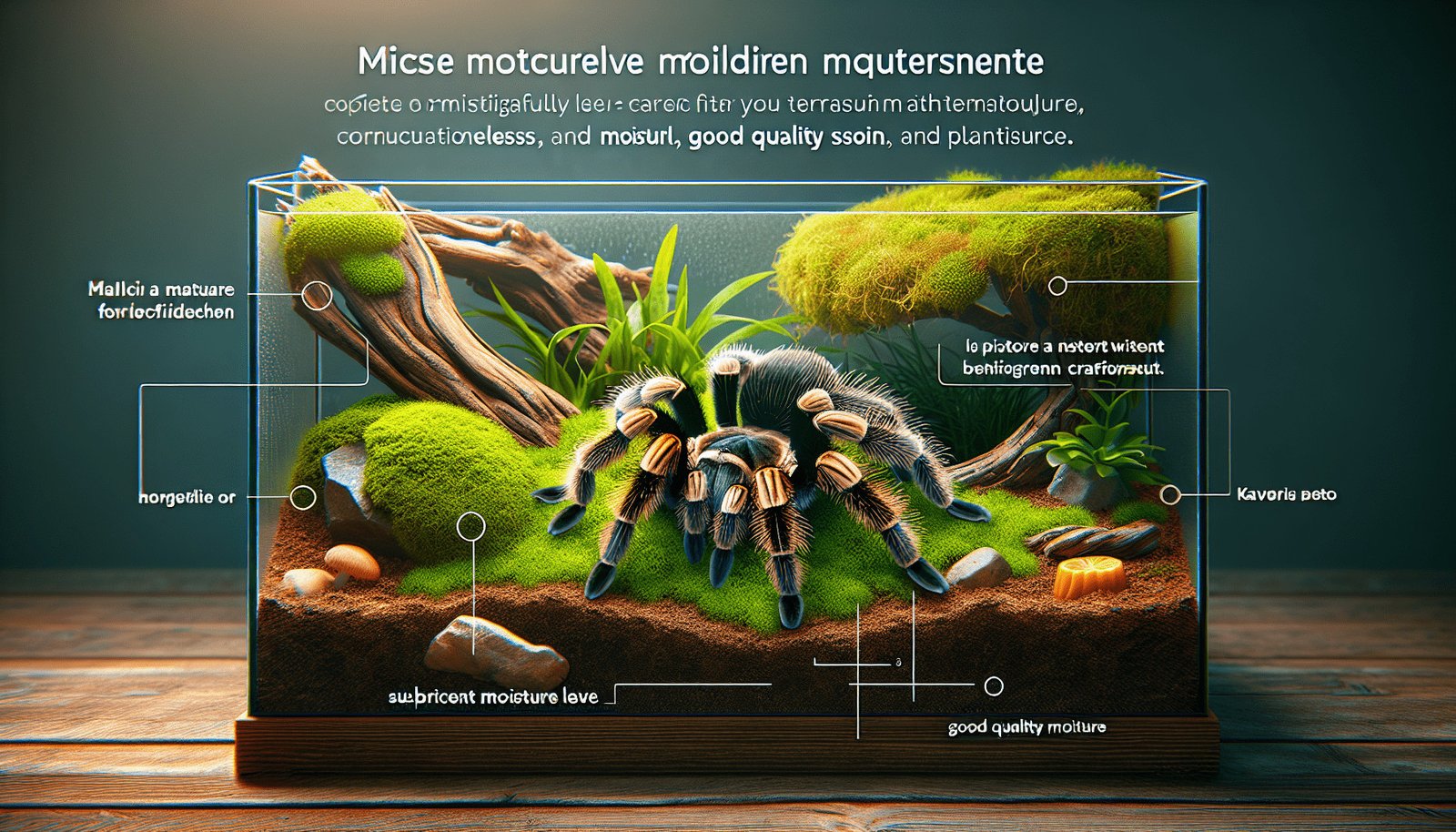Have you ever wondered how the moisture level of the substrate in your tarantula’s enclosure affects its health and well-being? Tarantulas, fascinating creatures with intriguing behaviors and needs, rely on the right environmental conditions to thrive. One of the key elements of their habitats is the substrate, particularly its moisture content. Understanding how substrate moisture impacts tarantula health is crucial for enthusiasts and caregivers aiming to provide optimal care.
Understanding the Basics of Tarantula Habitats
Before delving deeper into substrate moisture, it’s essential to grasp the basics of tarantula habitats. Tarantulas are found in various environments, ranging from arid deserts to humid rainforests. Thus, their moisture requirements can vary significantly. While some tarantulas thrive in drier conditions, others require consistently high humidity.
Natural Habitat Influences
Tarantulas in the wild have adapted to their specific environments. These adaptations influence their moisture needs. For instance, desert-dwelling species have developed ways to conserve moisture, while rainforest species rely on abundant humidity for their survival. Knowing where your tarantula species originates from can offer invaluable insights into its moisture requirements.
Importance of Mimicking Natural Conditions
Providing a habitat that closely mimics their natural environment is vital for tarantula health. Doing so ensures that your spider remains stress-free and healthy. The substrate choice and its moisture level are critical components of this mimicry, making substrate management an essential aspect of tarantula care.
Different Types of Substrates
There are several substrate options available for tarantula enclosures, each with its characteristics and abilities to retain moisture. Choosing the right substrate not only affects humidity levels but also impacts your tarantula’s safety and comfort.
Common Substrate Choices
| Substrate Type | Moisture Retention | Suitability |
|---|---|---|
| Coconut Coir (Coco Fiber) | High | Ideal for high-humidity species |
| Peat Moss | High | Suitable for burrowing species |
| Potting Soil | Moderate | Versatile, but watch for additives |
| Vermiculite | High | Excellent for moisture retention |
| Sand | Low | Best for arid species |
Each substrate has its pros and cons. It’s important to consider the specific needs of your tarantula and how each substrate type meets these requirements.
Factors to Consider When Choosing Substrate
When selecting a substrate, consider its ability to hold moisture, its texture, and how safe it is for your tarantula. Avoid substrates with strong scents or potential chemical treatments, as these can harm your tarantula.

Impact of Moisture Levels on Tarantula Health
The moisture level of the substrate has a profound impact on the health and behavior of tarantulas. These creatures rely on appropriate moisture levels for various physiological and behavioral reasons.
Behavioral Impacts
Tarantulas display specific behaviors based on moisture availability. Species that require damp conditions may exhibit stress or abnormal behavior if the substrate is too dry. These behaviors can include excessive movements, hiding, or refusal to eat.
Physiological Impacts
The proper moisture balance is crucial for physiological health. Dehydration in tarantulas can lead to molt complications, impaired kidney function, and weakened defense mechanisms. Conversely, overly moist conditions can encourage mold growth, affecting both the tarantula and its enclosure ecosystem.
Humidity and Molting
Molting is a significant phase in a tarantula’s life cycle, and moisture levels play a critical role during this time. Adequate humidity supports a successful molt, helping the tarantula shed its old exoskeleton smoothly. Poor humidity can lead to incomplete molts, which can be fatal.
Managing Substrate Moisture
Effectively managing the moisture level of the substrate is crucial for maintaining the health and overall well-being of your tarantula.
Monitoring Moisture Levels
Regularly monitoring the substrate’s moisture content is essential. This can be done through touch—for instance, feeling whether the substrate is damp. Investing in a hygrometer, a device that measures humidity, can provide precise readings and help manage moisture levels accurately.
Adjusting Moisture Levels
Adjusting the substrate’s moisture can be as simple as adding or reducing water. For species that require high humidity, periodic misting or using a water dish can help. It’s important to ensure that the water does not pool, as stagnant water can lead to mold growth and fungal infections.
Creating Microclimates
Creating microclimates within the enclosure can help meet the moisture needs of various tarantula species. This can include having one side of the enclosure more humid than the other, allowing the tarantula to choose where it feels most comfortable.

Potential Problems with Incorrect Moisture Levels
Inadequate moisture levels can lead to various problems, affecting both the tarantula and its habitat.
Dehydration Risks
Dehydration is a serious risk for tarantulas, leading to lethargy, refusal to feed, and eventually death. Ensuring that the substrate maintains appropriate moisture levels is essential to prevent this issue.
Mold and Fungal Growth
An overly damp substrate can become a breeding ground for mold and fungi, both of which are harmful to tarantulas. Keeping the enclosure clean and well-ventilated can help mitigate this risk.
Respiratory Issues
Incorrect moisture levels can contribute to respiratory issues in tarantulas. Ensuring that the enclosure is not too damp and has adequate airflow prevents the development of such problems.
Creating the Perfect Environment: Practical Tips
Providing the best possible habitat for your tarantula includes balancing moisture with other environmental factors. Here are some tips to help you create the ideal enclosure:
Choosing the Right Enclosure
The type of enclosure you choose can significantly affect the ability to maintain steady moisture levels. Glass tanks and plastic enclosures have different humidity-retention properties, which can be advantageous depending on your tarantula’s needs.
Ventilation Considerations
Proper ventilation is key in maintaining healthy humidity levels. Without adequate airflow, the enclosure can become too humid, leading to mold and respiratory issues. Adding ventilation holes or using mesh lids can improve airflow while maintaining necessary moisture levels.
Evaluating and Adjusting
Regular evaluation of the enclosure conditions ensures that the moisture levels meet the tarantula’s needs. Be prepared to adjust variables such as water availability, substrate type, and ventilation to provide a suitable living environment.

Conclusion
The impact of substrate moisture on tarantula health is undeniable, influencing both behavior and physiological processes. By understanding the moisture needs of your specific tarantula species and implementing effective moisture management techniques, you can ensure your tarantula thrives in its captive environment. Meeting these needs not only supports their health but also enhances your enjoyment and success as a tarantula caretaker. Striking the right balance in substrate moisture is a rewarding endeavor, leading to a healthier and happier tarantula under your care.
